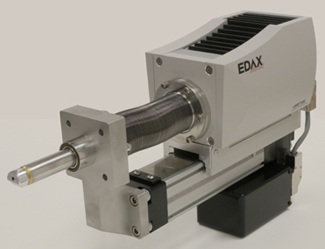Lưu ý: Tham khảo ý kiến của nhân viên INO sẽ giúp bạn tiết kiệm được thời gian và chi phí khi cần mua sắm. Với sự tư vấn của chúng tôi, bạn sẽ không gặp khó khăn khi tìm hiểu về đặc tính của sản phẩm cần mua.
EAM™ EDS Analysis System for TEM
EDAX's TEAM™ EDS system featuring new Apollo XLT Silicon Drift Detector (SDD) Series provides the ultimate analytical solution for Transmission Electron Microscope (TEM) applications. The series includes the Apollo XLT with a Super Ultra Thin Window (SUTW) and a windowless version, the Apollo XLTW. EDAX is the first microanalysis company to introduce a windowless version of an SDD detector. The Apollo XLTW provides optimum light element performance with complete transmission of low energy X-rays. When compared to an SUTW detector, the light element sensitivity is improved up to 500% and the count rate is increased by 30% for heavy elements. As a result, the mapping speed and light element detection in low concentrations are greatly enhanced with the Apollo XLTW.
| Features and Benefits
- All electronics are built into the detector to facilitate remote access, installation, service, and calibration
- Automated calibration algorithm for fast, repeatable, and accurate setup. Calibration data resides in the detector, eliminating the need to recalibrate when accessing remotely
- Compact detector system provides flexibility for each TEM installation
- 30mm2 SDD chip technology optimized for solid angle
- SUTW and windowless detectors are offered for superior light element performance with resolutions typically better than 59eV for Carbon
- Better than 129eV resolution for Manganese
- Resolution stability of < 1eV up to 100 kcps
- Peak shift of < 1eV up to 250 kcps
- Available amp times from 120 ns to 7.68 μs for optimal collection
- Fast Ethernet communication
- Motorized slide automatically retracts in response to excessive backscatter electrons
- TEM quantification algorithm for thin materials is available in TEAM™ EDS
|
| Apollo XLT SDD Series incorporates data acquisition and signal processing electronics into the detector to simplify installation and to eliminate the need for a separate data acquisition enclosure. The integrated detector presents an elegant design that improves performance and offers easy remote access via Ethernet from virtually any computer. Signal distortion and loss due to cable length have been eliminated. The PC can be located up to 100 meters away from the detector without affecting the performance. |

Spectra of SiO2 collected with the Apollo XLTW detector (shown in red) compared to a SiLi detector (shown in blue). The display of these spectra has been normalized to the highest energy part of the spectrum and shows that the Apollo XLTW is much more sensitive to low energy peaks. The Si K series peak intensity is improved by 30% and the O K by 150% with the Apollo XLTW detector. |
| Smart Features are at the core of our new TEAM™ EDS system with Apollo XLT for TEM. Intelligence has been built into the detector to provide the best protection against harmful conditions. The detector automatically retracts to a safe position when high energy electrons are detected. User intervention is not required, providing safe operation only achieved with Apollo XLT detectors. In case of maintenance needs, superior remote support is achieved with the detector's logging capability. The performance history recorded in the detector can be accessed remotely for a quick and accurate evaluation.
TEAM™ EDS is built with a modern interface equipped with Smart Features that are automated to simplify analysis and provide quick results. Regardless of the skill of the operator, consistent and accurate results are achieved effectively and efficiently every time. TEAM™ EDS automatically determines the elements in your sample, monitors the count rate and magnification, collection time, as well as numerous other parameters used for optimum system performance. Interactive review allows users to preview the results in a unique way before the completion of analysis. |
| The Apollo XLT SDD Series offers fully integrated data acquisition and signal processing electronics. Coupled with TEAM™ Smart Features, the system is the most intuitive and easy to use analytical tool available for the TEM. The Series offers a windowless version to further maximize collection efficiency and light element performance. TEAM™ Smart Features automate the work flow and revolutionize the way EDS analysis is done. Regardless of the skill of the operator, TEAM™ Smart Features provide exceptional results every time. The Apollo XLT SDD Series, in combination with TEAM™ EDS, provides the user with the most advanced EDS system for the TEM.
|

The TEM quantification algorithm for thin material is now available in TEAM™ EDS. The quantification model is based on the Cliff-Lorimer method for fast and accurate analysis. The user has the flexibility to work in conjunction with standards to determine one's own Cliff-Lorimer factors and theoretical methods. |
|
 |
|
|
|
|
 |
Lưu ý: Nếu một thiết bị nào đó không được liệt kê ở đây, điều đó không có nghĩa rằng chúng tôi không hỗ trợ được bạn về thiết bị đó.
Hãy liên hệ với chúng tôi để biết danh sách đầy đủ về thiết bị mà chúng tôi có thể hỗ trợ và cung cấp.
INO: Bán, Báo giá, tư vấn mua sắm và cung cấp, tư vấn sản phẩm thay thế; tương đương, hướng dẫn sử dụng, giá…VNĐ, …USD info@ino.com.vn | INO Sales: 028 73000184 | EDAX-Apollo XLT Silicon Drift Detector (Model: Series).




















